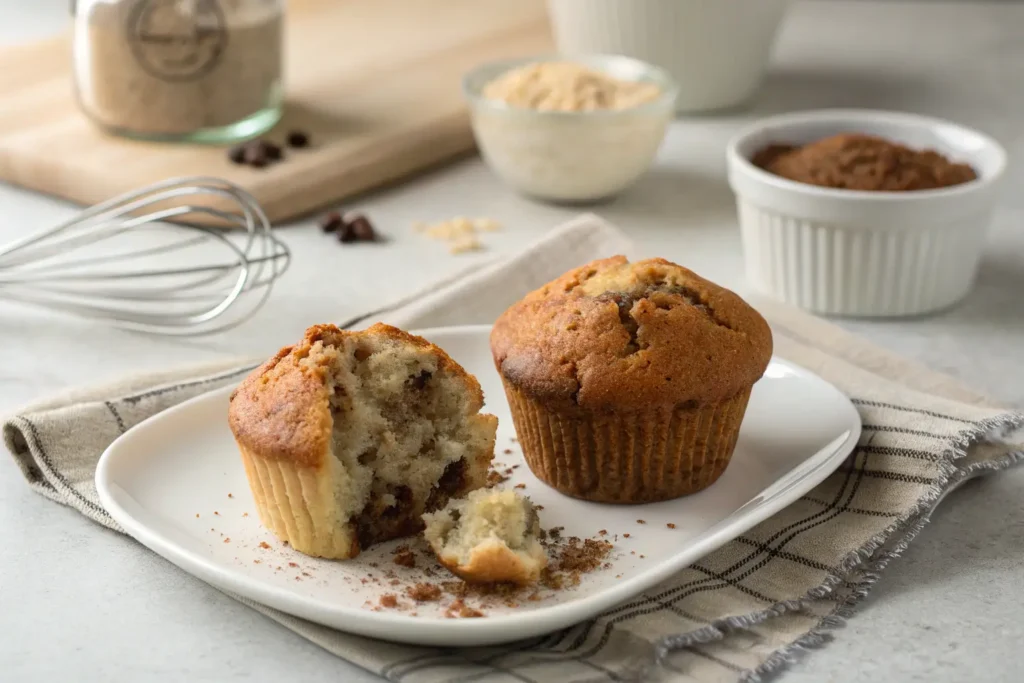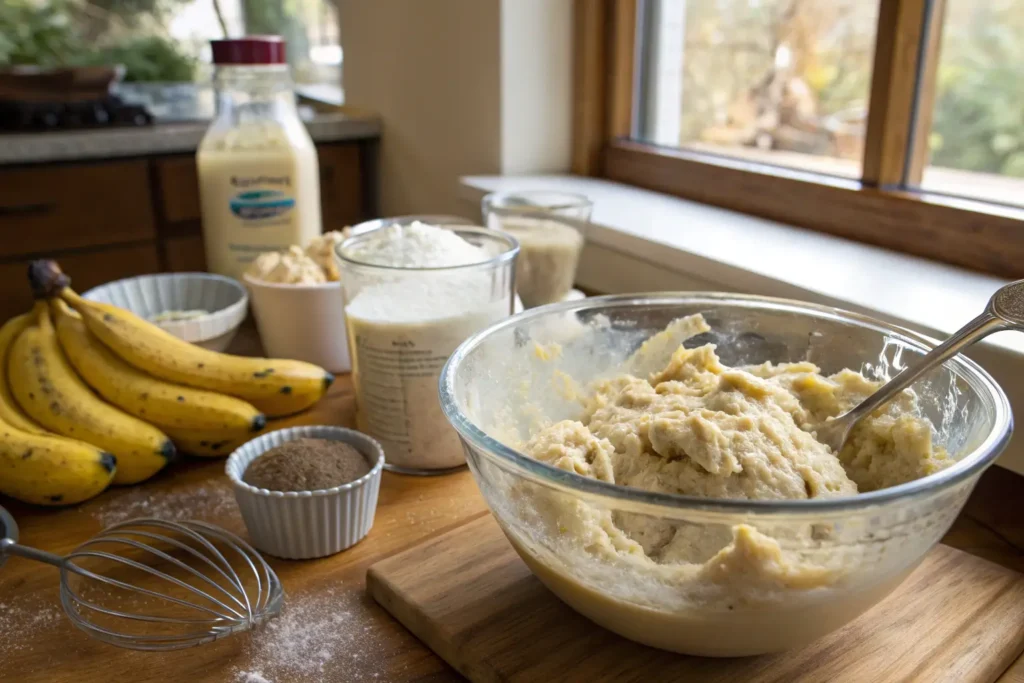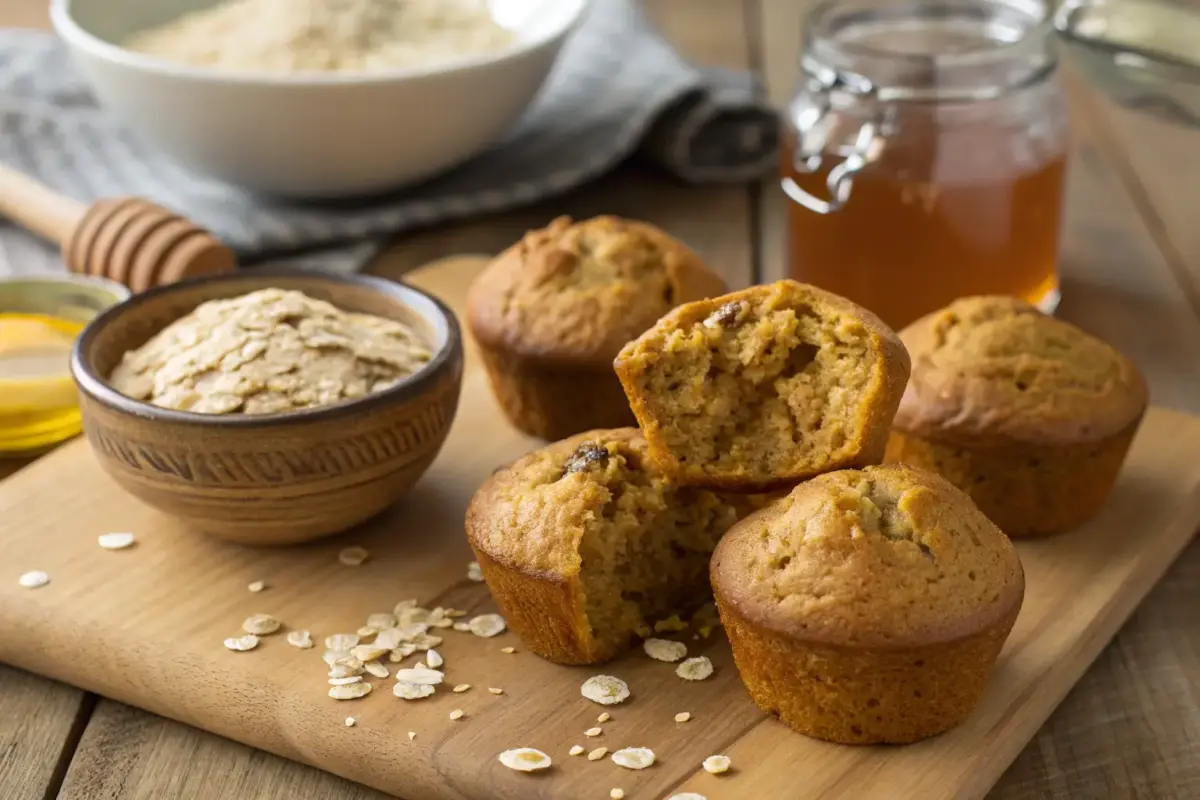Introduction
Let’s face it—there’s nothing worse than biting into a protein muffin expecting a moist, flavorful treat and finding something dry and crumbly instead. If you’ve been struggling with dry protein muffins, you’re not alone. Many people face this problem, but the good news is that it’s totally fixable. In this part, we’ll dive into the most common reasons your protein muffins might be turning out dry and how to avoid those pitfalls. Sound good? Let’s get started!
(Looking for inspiration? Check out how much protein is in a pumpkin muffin to explore unique muffin ideas.)
Common Causes of Dry Protein Muffins

Incorrect Measuring of Dry Ingredients
One of the biggest culprits behind dry protein muffins is measuring your dry ingredients incorrectly. You might think that a heaping scoop of protein powder or flour won’t make a difference, but trust me, it does. Too much dry mix can soak up all the moisture, leaving you with dense, dry muffins. Use measuring cups meant for dry ingredients and level them off with a flat edge for accuracy.
Overmixing the Batter
If you’ve ever been tempted to mix and mix and mix, thinking it will make your batter smoother—stop right there! Overmixing causes the gluten in the flour to develop, which can make your muffins tough and dry. Instead, mix just until the ingredients are combined. A few lumps? Totally fine!
Baking at a High Temperature
Baking protein muffins at too high a temperature might seem like a time-saver, but it’s not worth it. High heat can cook the outside too quickly while leaving the inside underdone. This uneven baking dries out the outer edges and can ruin the texture. Stick to the temperature specified in your recipe for the best results.
Overbaking the Muffins
Overbaking is an easy mistake to make, especially if you’re distracted (hello, multitaskers!). Even just a couple of extra minutes in the oven can zap the moisture out of your muffins. Always check for doneness with a toothpick and pull them out as soon as it comes out clean or with a few moist crumbs.
Cooling Muffins in the Pan for Too Long
Once your muffins come out of the oven, it’s tempting to let them cool in the pan while you take care of other things. But here’s the thing: leaving them in the hot pan too long keeps them cooking, drying them out even more. Transfer them to a wire rack as soon as they’re cool enough to handle.
Recipe Adjustments Leading to Dry Muffins
Substituting Ingredients Incorrectly
Ingredient swaps can seem like a fun experiment, but they can backfire if you’re not careful. For example, using whole wheat flour instead of all-purpose flour without adjusting liquids can absorb more moisture, making your muffins dry. Always research substitutions to ensure you’re balancing the recipe correctly.
(Want to experiment? Learn how you can add protein powder to boxed muffins without compromising texture.)
Using Protein Powders Without Balancing Liquids
Protein powder is a game-changer, but it’s also tricky. Different powders—like whey, casein, or plant-based—have different absorption rates. If you don’t tweak your liquids to match the protein powder you’re using, you’ll likely end up with dry muffins. A good rule of thumb? Add a splash more milk, yogurt, or whatever liquid your recipe calls for to keep things moist.
Reducing Fats or Oils Excessively
Trying to make your muffins super healthy by cutting out all the fats? I get it, but fats like butter, coconut oil, or even nut butter are essential for keeping muffins moist. You don’t have to go overboard, but don’t skimp too much either. A little fat goes a long way in keeping your muffins soft and flavorful.
Avoiding Moisture Loss in Protein Muffins
Adjusting Baking Time and Temperature
One of the easiest ways to keep your protein muffins moist is to get the baking time and temperature just right. Too much time in the oven? Dry muffins. Too high a temperature? Dry muffins again. For best results, bake at 325–350°F and keep an eye on them. Set a timer a few minutes before the recipe suggests so you can check for doneness early. And remember, ovens can be sneaky—what works for one might not work for another, so some trial and error may be needed!
Ensuring Proper Cooling Techniques
Believe it or not, how you cool your muffins can make or break their texture. When they come out of the oven, transfer them to a wire rack as soon as possible. This prevents residual heat from continuing to cook the muffins in the pan. If you’re worried about them drying out while cooling, lightly cover them with a clean kitchen towel to retain some moisture without trapping too much steam.
(Not a fan of protein powder? Discover substitutes for protein powder in muffins that keep your muffins moist.)
Impact of Incorrect Equipment or Techniques
Using the Wrong Measuring Tools
Okay, confession time: have you ever used the same measuring cup for both liquids and dry ingredients? If so, don’t worry—you’re not alone. But here’s the deal: this shortcut can lead to inaccurate measurements, which can throw off your recipe. For liquids, use a liquid measuring cup with a spout. For dry ingredients, go for dry measuring cups and level them off with a straight edge. This small change can make a big difference.
Failing to Calibrate the Oven Temperature
Ovens are like people—they all have their quirks. If your oven runs hot or cold, it can totally mess with your baking. An oven thermometer is a game-changer here. Place it inside your oven to check the actual temperature, and adjust the setting as needed. It’s a small investment for a big payoff—moist, perfect protein muffins every time.
The Role of Ingredients in Maintaining Moisture
Incorporating Natural Moisture Sources Like Yogurt or Applesauce
If your muffins have been feeling a little, well, thirsty, it’s time to bring in the big guns: natural moisture sources. Ingredients like Greek yogurt, applesauce, mashed banana, or even grated zucchini can work wonders. Not only do they add moisture, but they also pack in extra flavor and nutrients. It’s a win-win!
Choosing the Right Type of Protein Powder
Not all protein powders are created equal, and some are drier than others. Whey protein tends to be a bit lighter and less drying, while plant-based powders like pea or rice protein can soak up a ton of liquid. If you’re experimenting with a new powder, try reducing the amount slightly or adding extra liquid to keep the batter balanced. And hey, don’t be afraid to experiment—it’s part of the fun!
Advanced Tips for Perfect Protein Muffins

Adding a Humidity Barrier to the Batter
Let’s talk about one of the most underrated tricks in baking: adding a humidity barrier. This simply means using ingredients that trap moisture and prevent your muffins from drying out during baking. A tablespoon of sour cream, yogurt, or even a splash of heavy cream can work wonders. If you want a sweeter option, honey or maple syrup can also help because they naturally retain moisture. The key is moderation—just a small addition can keep your muffins soft without making them soggy.
Experimenting with Binding Agents
Binding agents might sound fancy, but they’re pretty straightforward. These ingredients hold your batter together and can improve texture while keeping your muffins moist. A popular choice is flaxseed meal mixed with water, also known as a “flax egg.” Simply mix one tablespoon of flaxseed meal with three tablespoons of water, let it sit for 5 minutes, and you’ve got a moisture-locking ingredient. Chia seeds work the same way. Psyllium husk is another great option if you’re looking for extra fiber and a tender crumb. Try adding a tablespoon to your batter and see the difference for yourself!
Layering in Hidden Moisture
Sometimes, you need to get sneaky with your ingredients. Adding grated zucchini, mashed bananas, or even finely shredded carrots can work wonders for locking in moisture. These natural moisture sources not only keep your muffins soft but also add nutrients without affecting the flavor too much. Ever tried adding applesauce to your batter? It’s a game-changer. Just remember to slightly reduce the liquid in your recipe if you’re using one of these ingredients to avoid overly wet muffins.
Playing with Oven Techniques
Rotating the Muffin Pan
This might sound simple, but it can make a big difference. Ovens often have hot spots that can cause uneven baking, leading to some muffins drying out faster than others. About halfway through baking, rotate your muffin pan to ensure even heat distribution. It’s a small step, but trust me, it’s worth it.
Steam It Up
Here’s a pro tip: add a small dish of water to the oven while baking your muffins. The steam helps maintain a moist environment, preventing the outer layer from drying out too quickly. This trick is especially useful if you’re baking a large batch or using protein powders that tend to soak up more liquid. Plus, it’s super easy—just pop a heat-safe dish with water on the lower rack, and you’re good to go.
Cover Mid-Bake
If your muffins start to brown too quickly, covering them with foil halfway through baking can save the day. This traps moisture inside and prevents the tops from drying out before the centers are fully cooked. Just be careful not to press the foil down too tightly—you don’t want it sticking to your beautiful muffin tops!
Ingredient Swaps for Better Moisture
Choose the Right Protein Powder
Protein powder is often the star of the show, but not all powders are created equal. Whey protein is a popular choice because it’s light and blends well without drying out the batter. Plant-based powders, on the other hand, can be trickier since they tend to absorb more liquid. If you’re using a plant-based powder, consider adding an extra tablespoon of liquid (like almond milk or water) to balance things out. And hey, don’t be afraid to experiment—finding the right protein powder for your recipe is part of the fun.
Don’t Skimp on Fats
I know, cutting out fats sounds like a good idea for a healthy treat, but it’s a recipe for dry muffins. Ingredients like coconut oil, butter, or even nut butters are essential for a soft texture. If you’re looking for a healthier alternative, try avocado oil or a mashed avocado. These options still provide the fat you need without compromising on your health goals.
Add a Touch of Sweetness
Even if you’re trying to keep your muffins low in sugar, a little bit of natural sweetness can make a huge difference in texture. Honey, maple syrup, or even a splash of fruit juice not only enhance flavor but also lock in moisture. Just keep it balanced—too much sweetness can overpower your recipe.
FAQs About : Why are my protein muffins dry?
How do I prevent my muffins from being dry?
Preventing dry muffins comes down to a few key practices. First, measure your ingredients accurately—too much flour or protein powder is a common mistake. Second, avoid overmixing the batter, as it can lead to dense, dry muffins. Finally, pay close attention to baking time and temperature. Pull your muffins out of the oven as soon as they’re done, and cool them on a wire rack to stop the cooking process.
Why are my protein balls too dry?
Dry protein balls usually happen when there’s too much dry mix (like protein powder or oats) and not enough binding ingredients. To fix this, try adding a spoonful of nut butter, honey, or even a little bit of milk until the mixture holds together. You can also refrigerate the mixture for 10–15 minutes before rolling to make it easier to handle.
Why are my protein pancakes so dry?
Dry protein pancakes are often the result of too much protein powder or not enough fat in the batter. To fix this, try adding a splash of milk, an extra egg, or a tablespoon of melted butter. Also, be mindful of your cooking temperature—cooking pancakes over high heat can dry them out before they’re fully cooked.
Why are protein cookies dry?
Protein cookies can dry out if the recipe doesn’t include enough fats or liquid ingredients. Ingredients like almond butter, coconut oil, or even mashed banana can make a big difference. Also, keep an eye on your baking time—cookies can go from perfect to overbaked in a matter of minutes.
Conclusion : Why are my protein muffins dry?
And there you have it—your ultimate guide to mastering moist protein muffins! From advanced baking techniques to smart ingredient swaps, these tips will take your muffin game to the next level. Whether you’re baking for meal prep, a quick snack, or a treat to share, you now have the tools to avoid dry, crumbly disasters. So grab your whisk, preheat your oven, and let’s get baking—because life’s too short for dry muffins!

